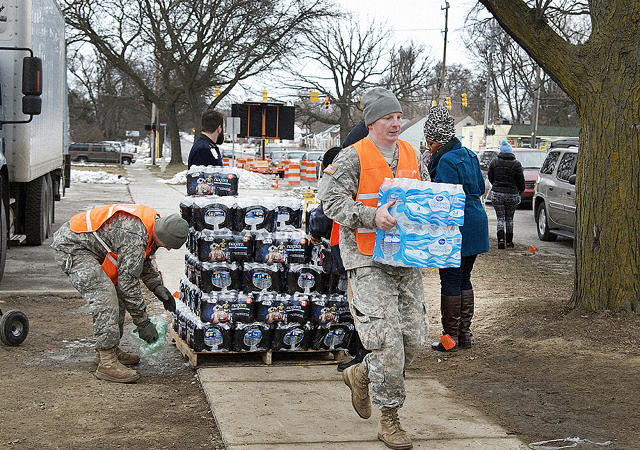How To Avoid Another Crisis Like Flint
The tragedy that is Flint, Michigan, should not be possible in the 21st century. In this time of Twitter, Facebook, and Instagram, it’s inconceivable that almost no one in the world knew that 100,000 people in the United States were without clean drinking water for more than a year. How could we so publicly fail to protect thousands of poor people of color only 10 years after Hurricane Katrina? Why in the richest country in the world were there still lead pipes delivering water to kids despite decades-old legislation against lead in water, air, and more starting in 1970? We cannot allow this to happen again.
Here are three essential things we have to do to avoid the next Flint:

Make it Easier for the Poor & Disenfranchised to Use Technology for Change
In today’s hyper-connected world, awareness of injustice often spreads fast and wide. Awareness doesn’t always solve problems, but it makes them much harder to ignore. In 2011, a tweet from Egypt’s Tahrir Square brought worldwide attention overnight to a brewing revolution. In 2012, 130,000 people signed an online petition in 36 hours and forced Verizon to change its billing practices. This kind of citizen reporting just didn’t happen in Flint.
Somehow, despite the ubiquity of Twitter and sites like Change.org where you can easily tell important stories and garner support, Flint’s crisis remained largely invisible to the outside world for over a year. I’m not referring to the equally outrageous fact that local and state officials knew about it and didn’t act. I’m referring to the fact that the tools that can raise awareness, create populist backlash, and apply external pressure on these officials were not used to do so.
This travesty must never be repeated. In part, this requires the nation to adopt a modern definition for community organizing that moves beyond helping residents pressure elected officials through traditional means. We need to ensure that residents, and community organizations that represent them, are equipped with additional engagement tools and capacities that allow them to organize quickly, continually and virtually and to harness masses of people outside of their community to help bring about change. With billions of dollars in assets, philanthropy must also do more to drive capital to these types of technology tools. More than 80% of low-income people have cell phones today. More work is needed to support people in doing so effectively.

Government Must Address Structural and Institutional Racism
Inequality goes beyond income and wealth. Inequality is also about where you live, what air you breath and what water you drink. Historically, we’ve depended on government to ensure equal access to safe air, food, and water. Yet, we are now confronted with the impacts of a 200-year legacy of discriminatory policies that drove segregation and unequal access to opportunity for people of color and the poor.
While the blatant, Jim Crow-era laws and practices have for the most part disappeared, the insidious impact of ongoing structural and institutional racism continues. In New Orleans during Hurricane Katrina, this meant that poor people of color were disproportionally in danger of losing everything, including, in too many cases, their lives. Often, policies and approaches not necessarily developed to have a disproportionately negative impact on people of color and neighborhoods do so in implementation. And, once in effect, these policies are often maintained despite their negative impacts.
That’s why government needs to hold a mirror up to itself. Government must understand which of its laws, policies, and practices perpetuate inequity–-whether in lead and copper water pipes or access to quality early education.
Philanthropy has a role in challenging cities to disrupt the status quo and interrogating long-standing policies and practices that might lead to inequity. There is incredible potential to implement “public sector audits”—looking at every city agency through a racial equity and inclusion lens to examine if their current ways of working have racially disparate results. In the wake of Flint, now is the time to ask these tough questions and double-down on solutions that can eliminate disparities for the poor and communities of color.

Infrastructure Must be Improved Much More Equitably
A crucial part of providing public services in a city, of course, is addressing aging infrastructure. As a nation, we’ve fallen into a trap of waiting for the federal government to fix our infrastructure problems—and we cannot wait anymore. Increasingly, cities have to cover these costs on their own, which requires enormous coordination and new financing mechanisms to address that large and growing need. And these costs take a toll on a city, diverting scarce resources from other critical services. Unsurprisingly, the heaviest burden then falls on poor neighborhoods and communities of color. In many ways, this tension is at the core of the Flint crisis. Flint’s infrastructure has failed its citizens. The current situation underscores the urgency of now, of the immediate need to come up with new and innovative ways to equitably meet cities’ infrastructure challenges.
It is well past time for cities to develop additional capacities to drive resources to infrastructure priorities. By smartly resourcing infrastructure, cities will be better equipped to tackle poverty, education, and job creation. With innovative solutions, they will have more funding to do so.
There is no question that the travesty that is Flint’s water crisis could have been avoided. As a nation, we must come to terms with our legacy of structural racism and leverage existing tools and solutions to dramatically improve the lives of low-income residents. The systems broke down in Flint. We must see what happened there as both a warning and a call to action. This call to action is about giving citizens a bigger megaphone and supporting them in telling their stories, confronting difficult truths about systemic racism, and developing innovative solutions to build a more equitable tomorrow.
Fast Company , Read Full Story
(47)














